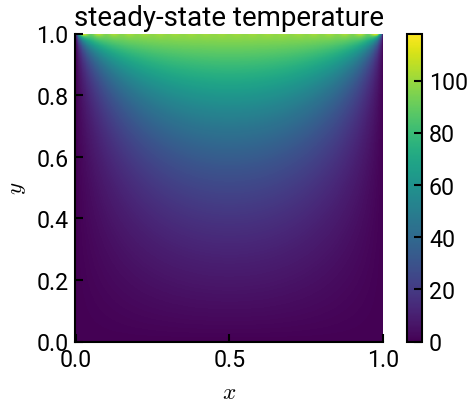9. 2D Laplace equation#
When studying equilibrium properties in engineering, you’ll likely come across the Laplace equation. This relies on calculating the Laplacian, which you learned in CME 100 as \(\nabla^2 \stackrel{\text{def}}{=} \dfrac{\partial^2}{\partial x^2} + \dfrac{\partial^2}{\partial y^2} + \dfrac{\partial^2}{\partial z^2}\). In this example, we will use it to model the steady-state temperature distribution in 2D, which can be solved using Fourier series and visualized.
Summary of commands#
In this exercise, we will demonstrate the following:
np.sinh(x)- Calculate the hyperbolic sine ofx.np.meshgrid(x, y)- Create a 2D grid of coordinate values based on 1Dxandyarrays.The result is two
XandY2D arrays with the corresponding 1D arrays tiled across the other dimension.
ax.pcolormesh(X, Y, C)- Create a pseudocolor plot ofCvalues on a grid defined by(X, Y).fig.colorbar(obj)- Add a color bar corresponding to theobjplot element.
Demo#
A rectangular plate is bounded by
with the following boundary conditions:
The steady-state temperature distribution is governed by \(\dfrac{\partial^2 T}{\partial x^2} + \dfrac{\partial^2 T}{\partial y^2} = 0\). The solution is:
Plot this temperature distribution.
# import libraries
import numpy as np
import matplotlib.pyplot as plt
# create grid
x = np.linspace(0, 1, 1000)
X, Y = np.meshgrid(x, x)
nmax = 40
# Fourier series
T = np.zeros(X.shape)
for n in np.arange(1, nmax, 2):
Bn = 400 / (n * np.pi * np.sinh(n * np.pi))
T += Bn * np.sin(n * np.pi * X) * np.sinh(n * np.pi * Y)
fig, ax = plt.subplots()
im = ax.pcolormesh(X, Y, T)
# im = ax.imshow(T, origin='lower') # multiple ways to solve a problem!
plt.colorbar(im)
ax.set(xlabel="$x$", ylabel="$y$", title="steady-state temperature", aspect='equal')
plt.show()

Tip
By default, Python 2D arrays have \((0,0)\) in the upper-left corner.
In ax.imshow(), we can explicitly pass the origin parameter to change the origin to the lower-left corner.

